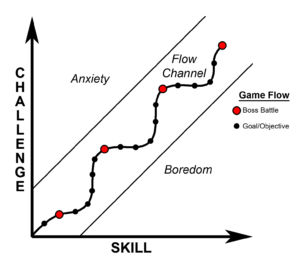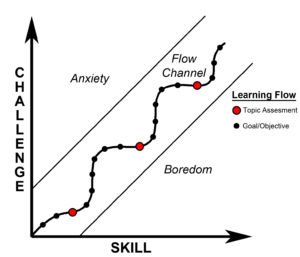In our first article on Gamification we explored basics, like rewarding badges to incentivize users. Now let’s take a deeper look at the attitude balance that must be maintained to keep your users happy!
Even when playing a fun game, users experience an internal seesaw of emotive reaction. In gaming, a “boss battle” is exactly what it sounds like: the player encounters a powerful boss with whom they must do battle. This is where the player’s true mettle is tested.
During the boss battle, the player will perceive anxiety if it is too difficult. An interesting fact is that the player will also experience boredom if it is too easy. The player wants to be challenged, but not too much. They want to exercise their skill, not mindlessly repeat tasks they have already learned.
This principle of balancing boredom and anxiety is applicable to maintaining user interest in eLearning as well. Both graphs are the same, except that in the gaming version the user is participating in a boss battle, whereas in the learning version they are participating in a topic assessment.
In either case, you can see clearly that when the user approaches maximum recommended challenge, they also approach anxiety. And when the challenge or skill required is too low, the user approaches boredom. The solution is to ride the wave of the flow channel such that when the user reaches an anxiety peak or boredom valley, then a trigger activates to adapt the context to the user’s particular needs. This is where computer adaptive testing is eLearning’s best friend!
 In an eLearning environment you can keep your users engaged by dynamically assessing their skill, and adjusting the difficulty of their learning path appropriately. Remember that there are two sides to this coin:
In an eLearning environment you can keep your users engaged by dynamically assessing their skill, and adjusting the difficulty of their learning path appropriately. Remember that there are two sides to this coin:
- Avoid frustration and anxiety by *decreasing* the difficulty.
- Avoid boredom by *increasing* the difficulty.
When you achieve this balance between anxiety and boredom, you ensure your users do not get frustrated simply due to a mismatch of difficulty level. The amazing thing about eLearning is that a computative environment means it is much easier to collect metrics on user status, even in real time! There is a great bounty of data that you can use to proactively calibrate your user experience.
Next time you play a game or take an online tutorial, be aware of the moments you feel frustrated, and consider whether it was because things were too hard, or too easy. Then you will see the flow channel boundaries that are ideal for your own personal UX. And the next step is the fun part: applying it to your development process. A little balance goes a long way!